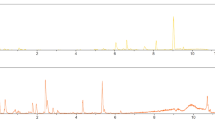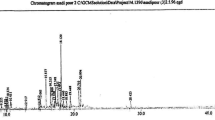Abstract
The composition of the lipophilic components of the Rhodiola rosea L. plant was studied. Acidic and neutral components were identified by gas chromatography–mass spectrometry. With methyl-tert-butyl ether (MTBE) as an extractant instead of the volatile solvent diethyl ether, lipophilic extract was obtained. Methyl-tert-butyl ether used as an extraction solvent for raw materials has all the advantages of diethyl ether, being free of its disadvantages. It does not form peroxides or produce elevated partial gas pressure due to its higher boiling point. As a result, comparison with databases identified some triterpene, phenolic, and aliphatic acids with chain lengths 12 to 30 carbon atoms, including saturated, unsaturated, and dibasic acids. In addition to the components known from the literature, more than 50 triterpene and aliphatic compounds were detected in the unsaponifiable residue and acidic fractions for the first time. The hexane extract and the product obtained by the stepwise extraction by MTBE after the extraction of low-polarity compounds with hexane were investigated in a similar way. In the case of an extract obtained using MTBE after the extraction of low-polarity components with hexane, extraction of benzoic and cinnamic acids was more efficient compared to the exhaustive extraction of MTBE. These acids are absent from the hexane extract. Ethanol extraction was also carried out to test bioactivity: exhaustive and after hexane and MTBE extraction. Extracts obtained using MTBE and ethanol showed antiviral activity against the Ebola pseudovirus.
Similar content being viewed by others
REFERENCES
Budantsev, A.L. and Lesiovskaya, E.E., Dikorastushchie poleznye rasteniya Rossii (Wild Useful Plants of Russia), St. Petersburg, 2001.
Brown, R.P., Gerbarg, P.L., and Ramazanov, Z., Rhodiola rosea: A phytomedicinal overview, Herbal Gram., 2002, vol. 56, pp. 40–52.
Wang, H., Ding, Y., Zhou, J., Sun, X., and Wang, S., The in vitro and in vivo antiviral effects of salidroside from Rhodiola rosea L. against coxsackievirus B3, Phytomedicine, 2009, vol. 16, pp. 146–155. https://doi.org/10.1016/j.phymed.2008.07.013
Kwon, Y.-I., Jang, H.-D., and Shetty, K., Evaluation of Rhodiola crenulata and Rhodiola rosea for management of type ii diabetes and hypertension, Asia Pacif. J. Clin. Nutr., 2006, vol. 15, pp. 425–432.
Krylov, G.V., Travy zhizni i ikh iskateli (Herbs of Life and their Seekers), Novosibirsk, 1969.
Bykov, V.A., Zapesochnaya, G.G., and Kurkin, V.A., Traditional and biotechnological aspects of obtaining medicinal preparations from Rhodiola rosea L. (a review), Pharm. Chem. J., 1999, vol. 33, pp. 29–40. https://doi.org/10.1007/BF02508414
Rastitel’nye resursy Rossii: Dikorastushchie tsvetkovye rasteniya, ikh komponentnyi sostav i biologicheskaya aktivnost’ (Plant Resources of Russia: Wild Flowering Plants, their Composition and Biological Activity), Budantsev, A.L., Ed., St. Petersburg: Tov-vo Nauch. Izdan. KMK, 2009, vol. 2.
Saratikov, A.S., Zolotoi koren’ (Rodiola rozovaya) (Golden Root (Rhodiola rosea)), Tomsk, 1974.
Krasnov, E.A., Chemical study and the possibility of using in medicine a number of plants of the Crassulaceae family of the flora of the USSR, Extended Abstract of Doctoral (Pharm. Sci.) Dissertation, Moscow, 1990.
Krasnov, E.A., Saratikov, A.S., and Surov, Yu.P., Rasteniya semeistva tolstyankovykh (Plants of the Crassulaceae Family), Tomsk, 1979.
Kurkin, V.A., Chemical study of Rhodiola rosea L., Extended Abstract of Cand. Sci. (Pharm. Sci.) Dissertation, Moscow, 1985.
Dikorastushchie poleznye rasteniya flory Mongol’skoi Narodnoi Respubliki (Wild Useful Plants of the Flora of the Mongolian People’s Republic), Leningrad, 1985.
Rohloff, J., Volatiles from rhizomes of Rhodiola rosea L., Phytochemistry, 2002, vol. 59, no. 6, pp. 655–661. https://doi.org/10.1016/s0031-9422(02)00004-3
Todorova, T.M., Evstatieva, L., Platicanov, S., and Kuleva, L., Chemical composition of essential oil from bulgarian Rhodiola rosea L. rhizomes, J. Essent. Oil. Bear. Plants, 2006, vol. 9, no. 3, pp. 267–270. https://doi.org/10.1080/0972060X.2006.10643502
Evstatieva, L., Todorova, M., Antonova, D., and Staneva, J., Chemical composition of the essential oils of Rhodiola rosea L. of three different origins, Pharmacogn. Mag., 2010, vol. 6, no. 24, pp. 256–258. https://doi.org/10.4103/0973-1296.71782
Ma, G., Li, W., Dou, D., Chang, X., Bai, H., Satou, T., Li, J., Sun, D., Kang, T., Nikaido, T., and Koike, K., Rhodiolosides A–E, monoterpene glycosides from Rhodiola rosea, Chem. Pharm. Bull., 2006, vol. 54, no. 8, pp. 1229–1233. https://doi.org/10.1248/cpb.54.1229
Bridel, M. and Beguin, C., Isolation of rutoside, asparagines and a new glycoside, hydrolysable by emulsion, salidroside from Salix triandra L., Seanc. Acad. Sci., 1926, vol. 183, pp. 321–323
Tolonen, A., Pakonen, M., Hohtola, A., and Jalonen, J., Phenylpropanoid glycosides from Rhodiola rosea, Chem. Pharm. Bull., 2003, vol. 51, no. 4, pp. 467–470. https://doi.org/10.1248/cpb.51.467
Akgul, Y., Ferreira, D., Abourashed, E.A., and Khan, I.A., Lotaustralin from Rhodiola rosea roots, Fitoterapia, 2004, vol. 75, no. 6, pp. 612–614. https://doi.org/10.1016/j.fitote.2004.06.002
Ali, Z., Fronszek, F.R., and Khan, I.A., Phenylalkaloides and monoterpene analogues from the roots of Rhodiola rosea, Planta Med., 2008, vol. 74, no. 2, pp. 178–181. https://doi.org/10.1055/s-2008-1034288
Ming, D.S., Hillhouse, B.J., Guns, E.S., Eberding, A., **e, S., Vimalanathan, S., and Towers, G.H., Bioactive compounds from Rhodiola rosea (Crassulaceae), Phytoter. Res., 2005, vol. 19, no. 9, pp. 740–743. https://doi.org/10.1002/ptr.1597
Petsalo, A., Jalonen, J., and Tolonen, A., Identification of flavonoids of Rhodiola rosea by liquid chromatography tandem mass spectrometry, J. Chromatogr., A, 2006, vol. 1112, pp. 224–231. https://doi.org/10.1016/j.chroma.2005.11.056
Panossian, A., Wikman, G., and Sarris, J., Rosenroot (Rhodiola rosea): Traditional use, chemical composition, pharmacology and clinical efficacy, Phytomedicine, 2010, vol. 17, pp. 481–493. https://doi.org/10.1016/j.phymed.2010.02.002
Hethelyi, E.B., Korany, K., Galambesi, B., Domokos, J., and Palinkas, J., Chemical composition of essential oil from rhizomes of Rhodiola rosea L. grown in Finland, J. Essent. Oil. Res., 2005, vol. 17, no. 6, pp. 628–629. https://doi.org/10.1080/10412905.2005.9699016
Shatar, S., Adams, R.P., and Koenig, W., Comparative study of the essential oil of Rhodiola rosea L. from Mongolia, J. Essent. Oil. Res., 2007, vol. 19, no. 3, pp. 215–217. https://doi.org/10.1080/10412905.2007.9699264
Marchev, A.S., Aneva, I.Y., Koycheva, I.K., and Georgiev, M.I., Phytochemical variations of Rhodiola rosea L. wild-grown in Bulgaria, Phytochem. Lett., 2017, vol. 20, pp. 386–390. https://doi.org/10.1016/j.phytol.2016.12.030
Mirmazloum, I., Ladányi, M., and György, Z., Changes in the content of the glycosides, aglycons and their possible precursors of Rhodiola rosea during the vegetation period, Nat. Prod. Commun., 2015, vol. 10, pp. 1413–1416.
Alperth, F., Turek, I., Weiss, S., Vogt, D., and Bucar, F., Qualitative and quantitative LC-MS analysis of different Rhodiola rosea rhizome extracts, Sci. Pharm., 2019, vol. 87, no. 2, p. 8. https://doi.org/10.3390/scipharm87020008
Ioset, K.N., Nyberg, N.T., van Diermen, D., Malnoe, P., Hostettmann, K., Shikov, A.N., and Jaroszewski, J.W., Metabolic profiling of Rhodiola rosea rhizomes by 1H NMR spectroscopy, Phytochem. Anal., 2011, vol. 22, pp. 158–165. https://doi.org/10.1002/pca.1262
Ganzera, M., Yayla, Y., and Khan, I.A., Analysis of the marker compounds of Rhodiola rosea L. (golden root) by reversed phase high performance liquid chromatography, Chem. Pharm. Bull., 2001, vol. 49, no. 4, pp. 465–467. https://doi.org/10.1248/cpb.49.465
Kukina, T.P., Frolova, T.S., and Salnikova, O.I., Neutral constituents of Chamaenerion angustifolium leaves, Chem. Nat. Compd., 2014, vol. 50, no. 2, pp. 233–236. https://doi.org/10.1007/s10600-014-0920-1
Kukina, T.P., Shcherbakov, D.N., Gensh, K.V., Tulysheva, E.A., Salnikova, O.I., Grazhdannikov, A.E., and Kolosova, E.A., Bioactive components of sea buckthorn Hippophae rhamnoides L. foliage, Russ. J. Bioorg. Chem., 2017, vol. 43, no. 7, pp. 57–61. https://doi.org/10.1134/S1068162017070093
Kukina, T.P., Shcherbakov, D.N., Gensh, K.V., Panteleeva, N.V., Tulysheva, E.A., Salnikova, O.I., Grazhdannikov, A.E., Kolosov, P.V., and Galitsyn, G.Yu., Bioactive components in methyl tert-butyl ether extract of sea buckthorn (Hippophae rhamnoides L.) green waste, Russ. J. Bioorg. Chem., 2020, vol. 46, no. 7, pp. 1372–1377. https://doi.org/10.1134/S1068162020070067
ACKNOWLEDGMENTS
The authors are grateful to the Shared Use Chemical Research Center of the Siberian Branch of the Russian Academy of Sciences for the GC–MS analysis.
Funding
The study was supported by the Russian Foundation for Basic Research (project nos. 19-34-90076 and 20-54-44016/20).
Author information
Authors and Affiliations
Corresponding author
Ethics declarations
The authors declare no conflicts of interest. This article does not contain any research involving humans or animals as research objects.
Additional information
Translated by N. Onishchenko
Rights and permissions
About this article
Cite this article
Kukina, T.P., Shcherbakov, D.N., Zybkina, A. et al. Effect of an Extractant on the Composition of the Lipophilic Constituents of the Extracts of Rhodiola rosea L. and on the Extracts’ Activity. Russ J Bioorg Chem 48, 1461–1469 (2022). https://doi.org/10.1134/S1068162022070147
Received:
Revised:
Accepted:
Published:
Issue Date:
DOI: https://doi.org/10.1134/S1068162022070147




